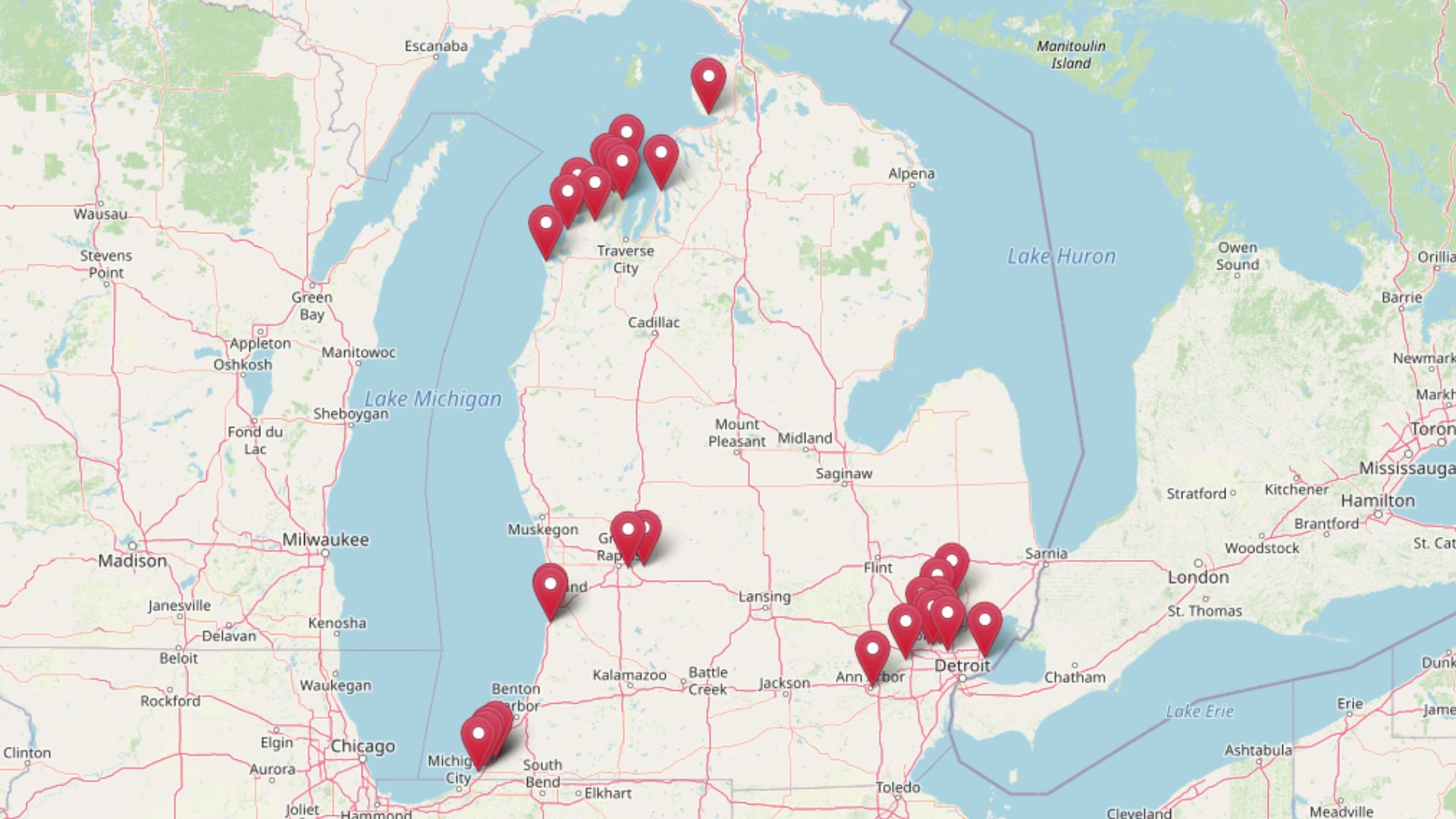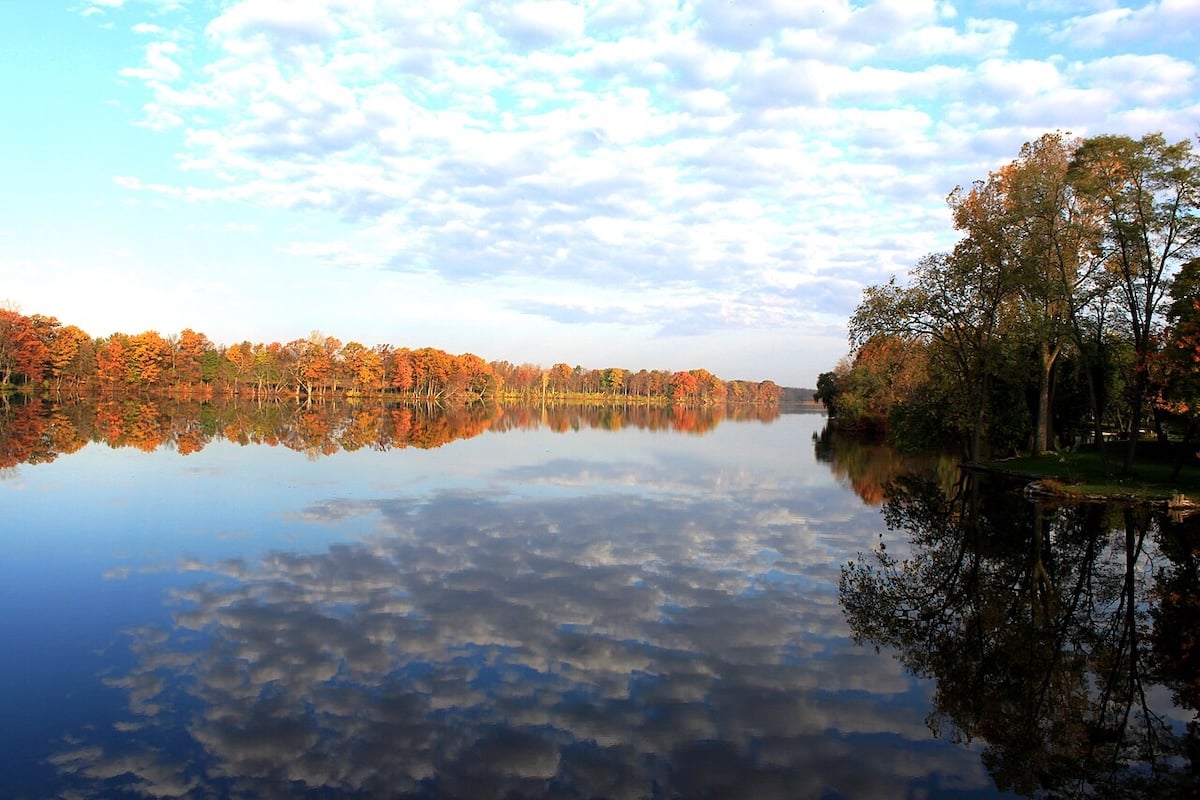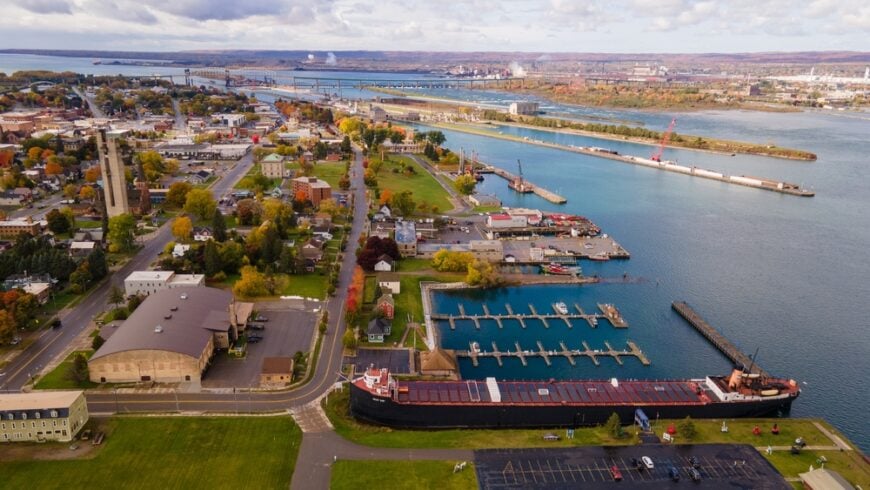
Whenever I crave a fresh perspective on the Great Lakes, I set my sights on Michigan’s small towns, where maritime museums and weather-worn lighthouses whisper stories of storms, shipwrecks, and stubborn ingenuity.
These communities may be modest in size, yet they brim with hands-on exhibits, preserved vessels, and waterfront walks that place me right alongside the mariners who once battled Superior gales or threaded the Straits of Mackinac.
From glass-bottom boat rides over submerged hulls to moonlit strolls on breakwalls, each stop offers a different lens on the state’s aquatic heritage. I love ducking into local cafés between museum visits, chatting with volunteers who gleefully share tales you won’t find on placards.
Hidden gems—whether an out-of-the-way lighthouse keepers’ dwelling or a shipwreck you can actually snorkel—reward anyone willing to linger. If you’re ready to chart your own course, here are the 17 best small towns in Michigan for exploring historical maritime museums, counted down from #17 to #1.
17. St. Ignace: Explore Fort de Buade Museum’s Maritime Collections

St. Ignace greets me the moment I cross the Mighty Mac, and its modest downtown quickly reveals a trove of nautical lore tucked inside the Fort de Buade Museum. Inside, I find fur-trade era canoes rubbing shoulders with Straits of Mackinac lighthouse lenses, offering a timeline that starts long before modern freighters.
Afterward, I like to catch a ferry to Mackinac Island or simply watch them depart while sampling freshly smoked whitefish from a dockside shack. Evening walks along the Huron Boardwalk showcase interpretive signs on 17th-century Jesuit missions and the commercial fishing boom that followed.
A lesser-known treat is the Museum of Ojibwa Culture, where I’ve learned how Indigenous boatbuilding informed later Great Lakes design. With easy access, deep history, and plenty of fresh perch dinners, St. Ignace sets a high bar for maritime exploration.
The average price for a 3-4 bedroom home in St. Ignace ranges from $250,000 to $350,000, offering a charming gateway to maritime history on the Great Lakes.
Where is St. Ignace?

Nestled at the northern foot of the Mackinac Bridge, St. Ignace anchors Michigan’s Upper Peninsula and commands sweeping views of the Straits where Lakes Huron and Michigan converge. This strategic position explains why so many shipping and shipwrecks occurred within sight of town.
I usually drive up I-75, but travelers can also arrive via the scenic US-2 shoreline route that hugs Lake Michigan’s northern coast. Once here, everything from museums to ferry docks sits within an easy, walkable mile.
16. Copper Harbor: Discover Maritime Tales at the Keweenaw County Historical Society

Perched at the tip of the Keweenaw Peninsula, Copper Harbor feels like the end of the earth and the start of a riveting maritime saga.
The Keweenaw County Historical Society curates exhibits on copper-laden schooners and the lighthouse keepers who braved Superior’s fury, and I never miss the boat shuttle to the Copper Harbor Lighthouse for an even closer look.
Between history lessons, I hit the legendary mountain-bike trails or wander the wave-washed rocks at Hunter’s Point Park. A glass-bottom tour over the sunken steamer John Jacob Astor offers a rare chance to spy 19th-century timbers through Superior’s crystal water.
Locals tip me off to Jamsen’s Fish Market, where a Lake Trout bagel pairs perfectly with sunset on the town dock. Up here, harsh storms and copper booms intertwine to create stories as rugged as the landscape.
Copper Harbor features 3-4 bedroom homes priced between $300,000 and $450,000, providing a scenic lakeside setting rich in nautical heritage.
Where is Copper Harbor?

Copper Harbor lies at US-41’s northern terminus, roughly 200 miles above Marquette yet feeling worlds removed from the bustle. The village sits where Lake Superior meets forested cliffs, giving it a remote, edge-of-map ambience ideal for lighthouse hopping.
I drive the spectacular Brockway Mountain Drive to reach town, though cyclists often tackle the same route for panoramic lake views. With no commercial airport nearby, the scenic drive becomes part of the adventure.
15. Leland: Wander Through Historic Fishtown

Leland’s weather-beaten shanties in Fishtown make me feel like I’ve stepped into a sepia photograph of Michigan’s commercial fishing heyday. I can spend hours watching charter captains unload salmon while the aroma of Carlson’s smoked chub drifts between cedar-plank huts.
The tiny Leland Historical Society Museum, tucked above the old icehouse, showcases gill nets, wooden skiffs, and tales of peril on Lake Michigan. Between exhibits, I board the Mishe-Mokwa ferry to the Manitou Islands, where ghost towns and shipwreck beaches extend the maritime theme.
Back ashore, artisan shops now occupy former fish sheds, yet the constant creak of dock lines keeps the past ever-present. Sunset from the breakwall, with gulls wheeling over moored tugs, ties the experience together.
3-4 bedroom homes in Leland typically cost between $350,000 and $500,000, making it an attractive destination for maritime enthusiasts.
Where is Leland?

Leland perches on a narrow strip between Lake Michigan and Lake Leelanau along the M-22 scenic route, about 25 miles north of Traverse City. This double-waterfront geography gave fishermen a safe harbor on two sides and still charms modern visitors.
I typically drive M-22’s curves, though summer cyclists love the route for its orchard and lake views. Parking is limited in peak season, so I often arrive early and explore on foot.
14. Frankfort: Visit the Historic Point Betsie Lighthouse
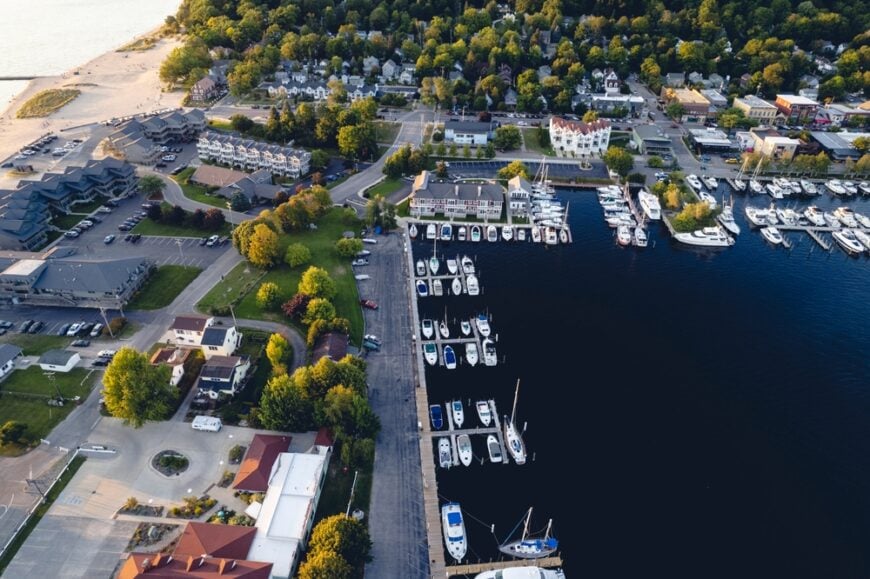
Frankfort’s twin lighthouses—Point Betsie guarding a windswept dune and the North Breakwater Light jutting into Lake Michigan—instantly immerse me in navigational history.
Point Betsie’s museum tour reveals Fresnel lenses and ship-to-shore signal flags, while the keeper’s quarters showcase life atop shifting sands. Downtown, the Benzie Area Historical Museum covers schooner traffic that once hauled lumber and salt from this port.
Between exhibits, I grab a cherry-filled pastry at Crescent Bakery before biking the Betsie Valley Trail to Elberta’s iron-ore docks. Evening brings locals and visitors alike to watch freighters thread the channel, a ritual that never gets old.
With Sleeping Bear Dunes just north, Frankfort pairs maritime heritage with some of Michigan’s most dramatic shoreline. Frankfort offers 3-4 bedroom homes ranging from $300,000 to $450,000, blending small-town charm with access to historic maritime museums.
Where is Frankfort?

Frankfort sits on Lake Michigan’s eastern shore at the mouth of the Betsie River, roughly 45 minutes southwest of Traverse City via US-31. Its harbor’s natural protection made it a vital lumber port in the 19th century and a popular marina today.
I usually arrive by car, but sailors often tie up in the municipal marina steps from Main Street. The short drive up M-22 to Point Betsie offers sweeping dune vistas you won’t soon forget.
13. Harbor Springs: Explore the Quaint Harbor and Maritime Past

Arriving in Harbor Springs, I’m struck by how the sailboat-speckled bay reflects a boating culture dating back to 1859 steamboat stops. The Little Traverse Historical Museum, housed in an old railroad depot, highlights regattas that once drew crowds rivaling today’s Fourth of July parade.
Just up Main Street, the Andrew J. Blackbird Museum discusses how Odawa fishermen navigated Little Traverse Bay long before yachts filled the marina.
I love strolling the wooden pier for an ice cream from Yummies and watching kids jump into water that’s startlingly clear. A quick drive up the Tunnel of Trees (M-119) leads to hidden coves and anecdotes about lifesaving stations along this rugged shoreline.
Harbor Springs may be petite, but its layered maritime story runs deep. Harbor Springs features 3-4 bedroom homes priced between $400,000 and $600,000, providing upscale lakefront living near cultural maritime sites.
Where is Harbor Springs?

Tucked on Little Traverse Bay’s north shore, Harbor Springs lies three miles across the water from Petoskey and about 15 minutes off US-31. Its naturally deep harbor, framed by bluffs, made it a coveted anchorage for both steamers and Native canoes.
I generally drive in via M-119, but boating in from Lake Michigan provides a dramatic first glimpse of the town’s white church steeples. Everything downtown is easily walkable once you dock or park.
12. Rogers City: Delve into History at the Great Lakes Lore Maritime Museum

Rogers City’s Great Lakes Lore Maritime Museum honors the sailors themselves, showcasing diaries, uniforms, and an emotional memorial wall that always stops me in my tracks. Just down the street, I watch 1,000-foot freighters loading limestone at the massive Calcite Quarry, a living display of industry meeting inland sea.
Hoeft State Park, a few miles north, lends forested trails that end at a secluded beach perfect for pondering ships on the horizon. Before leaving, I climb the spiral stairs of Forty Mile Point Lighthouse, a lesser-known beacon offering panoramic views and exhibits on the steamer Joseph S. Fay wreck nearby.
Pairing heartfelt storytelling with active shipping, Rogers City delivers history that feels alive and working. Rogers City offers 3-4 bedroom homes ranging from $150,000 to $250,000, making it an affordable choice for those interested in Great Lakes maritime history.
Where is Rogers City?

Located on Lake Huron’s Thunder Bay to the north and 40 miles north of Alpena along US-23, Rogers City benefits from deep-water docks carved by limestone extraction.
Its shoreline position halfway between the Straits and the Saginaw Bay made it a logical rest stop for freighters. I usually follow the Lake Huron Circle Tour route, which parallels the beach nearly the entire way. Ample roadside pull-offs let me admire the lake before I even reach town.
11. Grand Haven: Discover the Tri-Cities Historical Museum’s Maritime Exhibits

Grand Haven blends maritime history with a festival atmosphere I can’t resist, especially during the Coast Guard Festival when vintage cutters dock downtown. The Tri-Cities Historical Museum’s maritime wing houses ship models, foghorns, and a riveting film on the 1956 Carl D. Bradley tragedy.
After soaking in the exhibits, I stroll the 1.5-mile boardwalk to the iconic red pierhead lights, timing my return for the Grand Haven Musical Fountain’s nightly water-and-light show. A lesser-known stop is the small but fascinating U.S. Life-Saving Service station tucked behind Escanaba Park, where surfboats hint at daring rescues.
Between beach days and history lessons, Grand Haven balances learning with laid-back lake fun. Grand Haven features 3-4 bedroom homes priced between $350,000 and $500,000, blending beach town charm with a rich nautical past.
Where is Grand Haven?
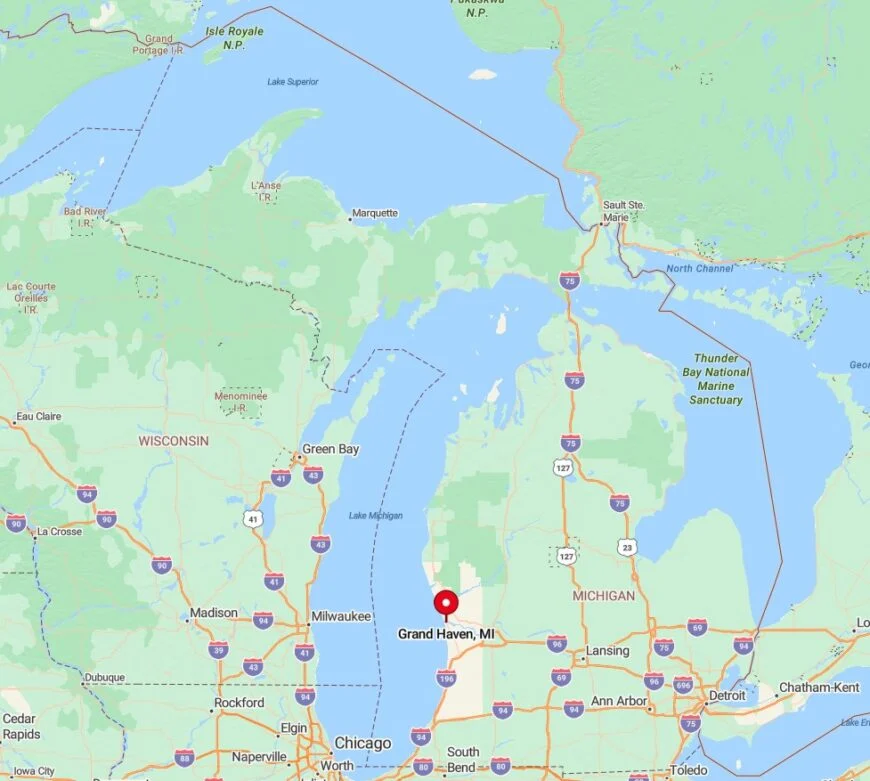
Grand Haven sits at the mouth of the Grand River on Lake Michigan’s eastern shore, roughly 30 miles west of Grand Rapids via I-96 and US-31. Its river harbor provided natural shelter, securing its role as a life-saving and Coast Guard hub.
I often bike the Lakeshore Trail from Holland for a car-free arrival complete with dune vistas. Once in town, free summer trolley service makes exploring easy.
10. Charlevoix: Enjoy Lakeside Charm and Maritime Heritage

Charlevoix captivates me with Round Lake’s sheltered marina linking directly to Lake Michigan via the busy Pine River Channel. The Charlevoix Historical Society’s Depot Museum details how passenger steamers once disembarked summer vacationers here long before the modern yacht crowd arrived.
I wander to the South Pier Light for sunset, passing Earl Young’s whimsical “Mushroom Houses” built with wave-rounded stones—quirky reminders of the lake’s influence on local architecture.
On Saturday mornings, the farmers market spills onto the waterfront, and I never skip the smoked whitefish dip from John Cross Fisheries. For a hidden gem, I charter a ride to the 1892 Ile Aux Galets Lighthouse on nearby Fisherman’s Island, which feels miles from civilization.
Charlevoix combines postcard beauty with a seafaring spirit that still hums. Charlevoix offers 3-4 bedroom homes ranging from $400,000 to $600,000, providing picturesque views and easy access to maritime museums.
Where is Charlevoix?
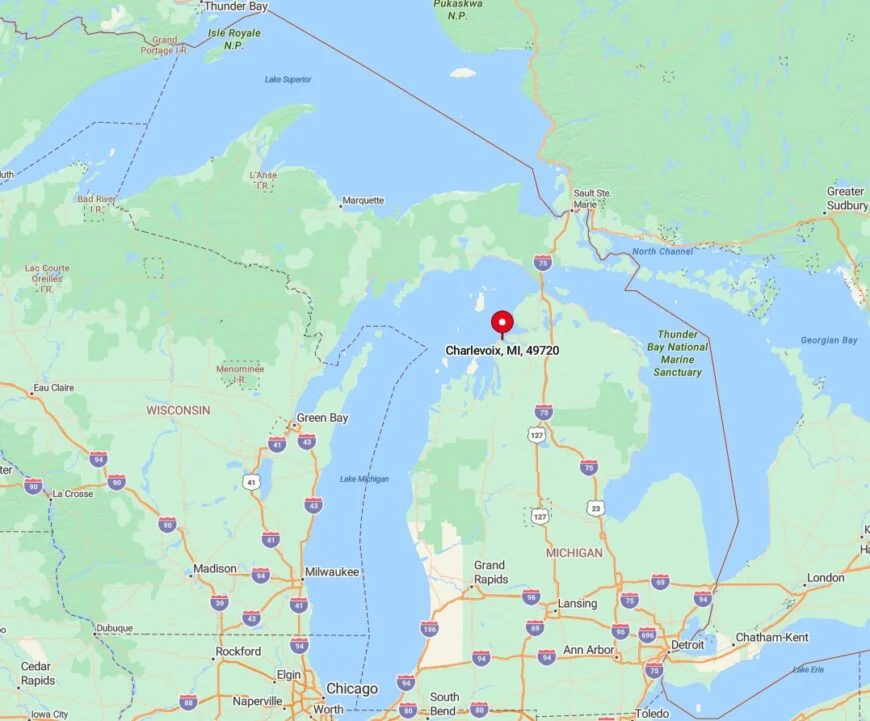
This bustling harbor town sits along US-31 between Petoskey and Traverse City, with Lake Michigan on one side and Lake Charlevoix feeding into Round Lake on the other. The unique “inland-to-Great-Lake” connection created a natural crossroads for past steam traffic.
I often arrive by car, though the Beaver Island ferry departs right downtown, adding another nautical layer. With everything clustered around the channel, it’s easy to explore on foot.
9. Port Sanilac: Explore Nautical History at the Sanilac County Historic Village & Museum

Port Sanilac may appear sleepy, but its Historic Village & Museum hides a wealth of maritime artifacts inside the 1872 loop-and-tail lighthouse keeper’s dwelling, ranging from brass fog bells to Mackinaw boat models.
Docents recount how schooners hauled timber and farm goods from this Thumb coast port, and I always linger in the replica blacksmith shop to hear tales of anchor forging.
After the museum, I stroll the quiet harbor where charter captains now ply waters once crowded with grain boats. Offshore, scuba divers explore the Sanilac Shores Underwater Preserve—an insider tip for wreck enthusiasts comfortable with cold water.
Evenings find me at a lakeside bonfire listening to gulls and re-imagining lantern signals across Huron’s dark horizon. Port Sanilac features 3-4 bedroom homes priced between $250,000 and $400,000, perfect for those who want a coastal lifestyle steeped in maritime tradition.
Where is Port Sanilac?
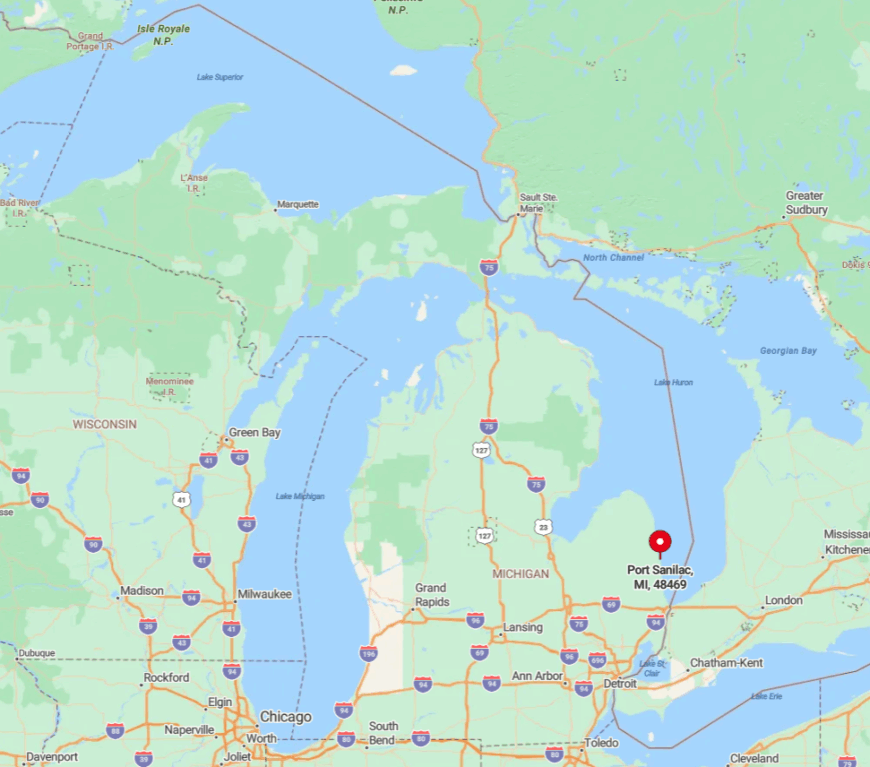
Set midway up Michigan’s Thumb along M-25, Port Sanilac lies about 30 miles north of Port Huron and 70 miles east of Flint. Its limestone reefs and shallow bars once made navigation tricky, prompting the construction of the still-active lighthouse.
I follow the Lake Huron shoreline drive, whose rural scenery underscores the town’s isolation. With limited public transit, driving is easiest, though boaters often anchor in the small marina for a quiet layover.
8. Marquette: Discover the Marquette Maritime Museum

Marquette channels Lake Superior’s raw power into compelling history at the Marquette Maritime Museum, where dioramas of the infamous 1913 storm sit alongside a recovered Coast Guard surfboat.
A guided walk to the 1896 Harbor Lighthouse reveals catwalks once used by keepers braving waves that still crash spectacularly today. I balance museum time with hikes at Presque Isle Park, where I often spot ore boats threading the channel past the hulking historic ore dock.
For thrills, locals point me to Black Rocks for a freshwater cliff jump, followed by hot cocoa at Dead River Coffee. On blustery days, the museum’s collection of shipwreck artifacts—like the bell from the George M. Cox—feels especially poignant.
Marquette blends outdoor adventure with sobering Superior lore like nowhere else. Marquette offers 3-4 bedroom homes ranging from $300,000 to $450,000, making it a vibrant university town with a strong maritime heritage.
Where is Marquette?

As the Upper Peninsula’s largest city, Marquette sits on Superior’s southern shore along US-41, roughly a two-hour drive west of the Mackinac Bridge. Its deep natural harbor and nearby iron mines positioned it as a key ore-shipping hub.
I usually fly into Sawyer International Airport 20 minutes south, but Amtrak Thruway buses and scenic drives offer alternatives. Once downtown, a paved lakeside multi-use path links the museum, lighthouse, and beaches with ease.
7. Manistee: Step Back in Time on the S.S. City of Milwaukee

Manistee’s crown jewel is the S.S. City of Milwaukee, a 1931 railroad car ferry turned floating museum, where I can walk through ornate staterooms and peek into the massive engine room.
The adjacent USCGC Acacia, a retired buoy tender, extends the maritime immersion with stories of icebreaking and lighthouse supply runs. On shore, the Riverwalk traces the Manistee River past Victorian storefronts erected during the logging boom that once filled schooner holds.
I like ending the day fly-fishing below Tippy Dam, imagining lumber era rafts bound for Chicago. For a spooky twist, the ferry hosts popular haunted tours each October—a detail many travelers miss.
Together, these experiences paint a vivid portrait of commerce and courage on Lake Michigan. Manistee features 3-4 bedroom homes priced between $250,000 and $400,000, offering historic charm and lakeside access for maritime enthusiasts.
Where is Manistee?

Manistee sits where its namesake river meets Lake Michigan, roughly halfway between Ludington and Frankfort along US-31. The protected river channel allowed car ferries like the City of Milwaukee to winter safely in port.
I often reach town via the scenic M-22 loop, though smaller regional airports in Manistee and Traverse City provide flight options. A compact downtown means you can park once and explore museums, shops, and the shoreline on foot.
6. Sault Ste. Marie: Tour the Museum Ship Valley Camp

Sault Ste. Marie’s Museum Ship Valley Camp lets me roam a full-size Great Lakes freighter, where two original lifeboats from the Edmund Fitzgerald stand as solemn reminders of Superior’s might.
Interactive cargo holds house aquariums stocked with native fish, making the tour surprisingly lively for kids and adults alike. After disembarking, I head to the Soo Locks observation deck to watch modern giants rise and fall 21 feet between Lakes Superior and Huron.
The nearby Tower of History provides a 210-foot vantage point over international shipping lanes—bring binoculars for best effect. For a lesser-known outing, I hop the Sugar Island ferry to explore quiet shorelines that once hosted Ojibwa canoe routes.
With industry, tragedy, and engineering marvels on display, the Soo delivers maritime drama in real time. Sault Ste. Marie offers 3-4 bedroom homes ranging from $200,000 to $300,000, providing affordable living near the famous Soo Locks and maritime museums.
Where is Sault Ste. Marie?

Straddling the Canadian border at the St. Marys River rapids, Sault Ste. Marie lies at I-75’s northern terminus, about 50 minutes north of St. Ignace. Its location at the only natural outlet of Lake Superior made it essential for ship traffic, prompting the construction of the Soo Locks in 1855.
I usually drive, but regional flights into Chippewa County International or VIA Rail service across the bridge offer alternatives. Once downtown, a waterfront trolley loops between the Valley Camp, locks, and the historic district.
5. Whitefish Point: Visit the Great Lakes Shipwreck Museum
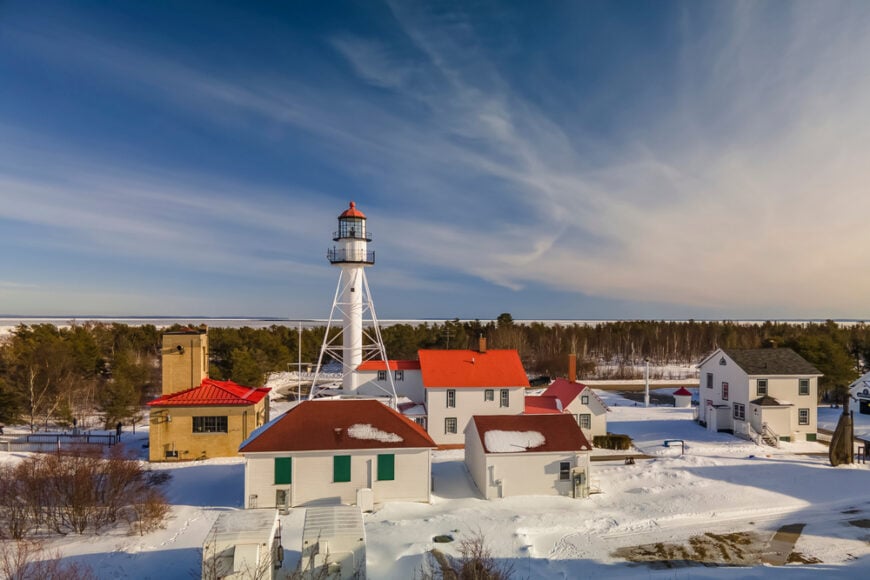
Whitefish Point feels hauntingly remote, which makes its Great Lakes Shipwreck Museum all the more compelling: I still get chills standing before the recovered bell of the Edmund Fitzgerald as Superior’s surf thunders outside.
The adjacent 1849 lighthouse tower, Michigan’s oldest on the lake, offers sweeping views over a notorious stretch nicknamed the “Graveyard of the Great Lakes.” Between museum buildings, signage points to the remains of over 200 wrecks hidden beneath the waves just offshore.
Birders flock here too; the Whitefish Point Bird Observatory tracks migrations so dense I’ve watched hawks kettling overhead by the hundreds. For solitude, I wander the sandy point at dusk, imagining lantern lights once used to guide stricken vessels toward safety.
The mix of tragedy, perseverance, and wild beauty is unforgettable. Whitefish Point features 3-4 bedroom homes priced between $150,000 and $250,000, reflecting the area’s commitment to maritime history and lighthouse preservation.
Where is Whitefish Point?

Whitefish Point juts into Lake Superior 11 miles north of Paradise via M-123, itself about 70 miles northwest of Sault Ste. Marie. The point’s exposed position helps explain the high concentration of shipwrecks memorialized in the museum.
I drive through the thick Hiawatha National Forest, a journey that heightens the sense of isolation. With no public transit, a personal car or motorcycle is essential, and cell service can be spotty—part of the adventure.
4. South Haven: Immerse in History at the Michigan Maritime Museum

In South Haven, the Michigan Maritime Museum’s campus of historic vessels keeps me busy for hours, from climbing aboard the replica War of 1812 topsail sloop Friends Good Will to touring the 1903 fish tug Evelyn S. Southard.
Indoors, interactive exhibits trace everything from lifesaving surfboat drills to the evolution of pleasure boating on Lake Michigan. When the museum’s tall ship sets sail, I always snag a ticket for a hands-on cruise that ends with cannon fire echoing off the breakwater.
Downtown’s riverfront buzzes with cafés, but I slip away to North Beach for lighthouse photos in golden light. An insider tip: time your walk across the historic Dyckman Avenue drawbridge to coincide with its hourly raises for passing masts.
South Haven ties living history to modern lake life with ease. South Haven offers 3-4 bedroom homes ranging from $350,000 to $550,000, combining a lively harbor town atmosphere with rich nautical traditions.
Where is South Haven?

Positioned at the mouth of the Black River, South Haven lies along I-196 exactly halfway between Chicago and Grand Rapids, making it an easy weekend destination. The harbor’s deep channel and mid-lake location made it a key port for fruit steamers and fishing fleets.
I often arrive via the Kal-Haven Trail by bike from Kalamazoo, enjoying a car-free roll into downtown. Once in town, everything from the museum to the beaches sits within a pleasant 15-minute walk.
3. Alpena: Uncover Shipwrecks at the Great Lakes Maritime Heritage Center

Alpena’s Great Lakes Maritime Heritage Center plunges me into Thunder Bay National Marine Sanctuary, where over 200 preserved wrecks rest in remarkable clarity.
The museum’s full-size replica schooner deck rocks beneath my feet as surround-sound storms simulate life on Lake Huron—kids squeal, adults grip railings. Outside, I hop on a glass-bottom boat tour that glides over the intact hull of the steamer Monohansett and other relics visible from the surface.
Back on shore, the harborside Art in the Loft gallery and historic downtown breweries round out the day nicely. For a hidden spot, I hike to Island Park to watch herons fishing beside the drawbridge, a peaceful counterpoint to the museum’s high drama.
Alpena turns underwater archaeology into an accessible adventure. Alpena features 3-4 bedroom homes priced between $200,000 and $350,000, providing affordable access to the Thunder Bay National Marine Sanctuary.
Where is Alpena?

Alpena sits on Lake Huron’s Thunder Bay along US-23, about a two-hour lakeside drive north of Bay City. Its natural harbor and protective islands made it a lumber-shipping powerhouse and, later, the nucleus of America’s first freshwater marine sanctuary.
I typically fly into Alpena County Regional Airport or drive the scenic Sunrise Coast Highway. The museum anchors a revitalized riverfront district that’s easy to wander on foot.
2. Ludington: Discover the S.S. Badger and Ludington Maritime Museum

Ludington buzzes each morning when the S.S. Badger sounds her whistle before backing out for her four-hour voyage to Wisconsin, a ritual I never tire of watching from the pier.
The Ludington Maritime Museum, housed in the 1879 U.S. Life-Saving Station, chronicles the city’s era of car ferries that once numbered seven and carried railcars across stormy waters.
After touring vintage rescue gear, I hike the beach to Big Sable Point Lighthouse, where volunteers share stories of kerosene lamplight and epic dune storms. Evening belongs to a cone at House of Flavors, followed by sunset on the North Breakwater Light catwalk—waves splash, gulls cry, and everything feels timeless.
For a lesser-known thrill, I kayak the Pere Marquette River at dawn, drifting past steam-era pilings swallowed by cattails. Ludington marries living ferry heritage with classic beach-town vibes.
Ludington offers 3-4 bedroom homes ranging from $250,000 to $400,000, making it an appealing destination for lovers of maritime museums and lakefront living.
Where is Ludington?

Ludington occupies Lake Michigan’s eastern shoreline at the mouth of the Pere Marquette River, accessed via US-10, which runs straight from I-96. Its deep natural harbor and rail link made it ideal for car ferries like the Badger, still the lake’s last coal-fired steamship.
I sometimes board the Badger as a foot passenger, letting the ferry itself become my transportation. Once ashore, the museum, pier, and downtown all cluster within a mile.
1. Mackinaw City: Explore the Historic Icebreaker Mackinaw Maritime Museum

No Michigan maritime tour feels complete without stepping aboard the retired U.S. Coast Guard Icebreaker Mackinaw WAGB-83, now permanently moored in Mackinaw City.
As I wander her immense steel decks, guides recount winter rescues and ore convoys escorted through 30-foot ice—stories that make the vessel’s nickname “Queen of the Great Lakes” ring true.
Back on land, I explore the Old Mackinac Point Lighthouse, whose fog signal building hosts interactive exhibits on Great Lakes navigation. I like to cap the day with a stroll through Colonial Michilimackinac, an 18th-century fort where fur-trade canoes once launched into Lake Huron.
After sunset, I head to Headlands International Dark Sky Park, a local secret for stargazing where lighthouse beams compete only with the Milky Way. Mackinaw City’s mix of engineering marvels, living history, and natural wonder earns it the countdown’s top spot.
Mackinaw City features 3-4 bedroom homes priced between $300,000 and $450,000, offering proximity to historic forts and maritime landmarks on the Straits of Mackinac.
Where is Mackinaw City?
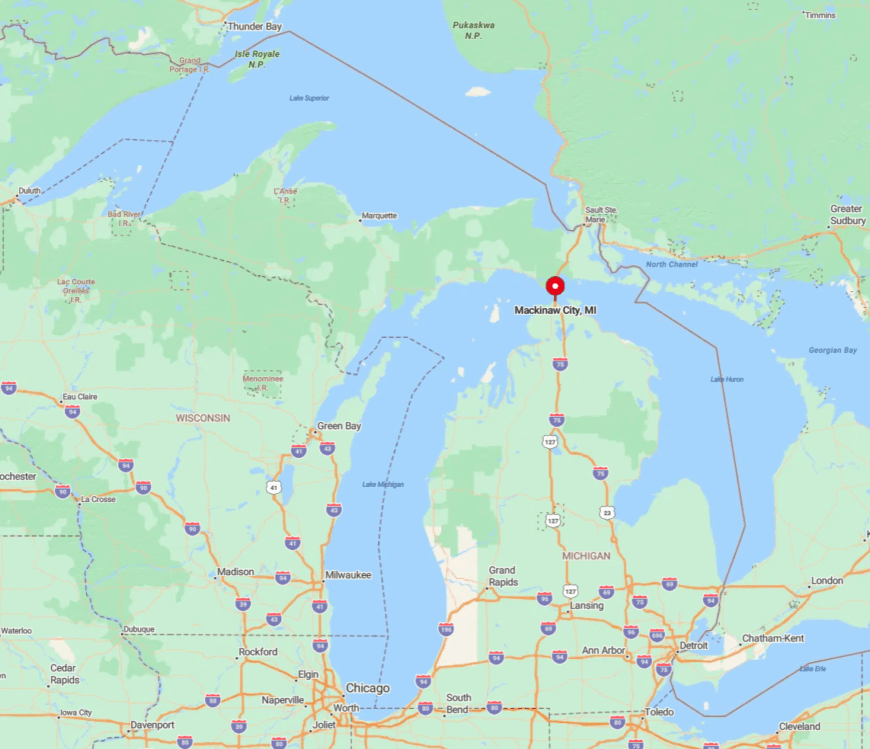
Mackinaw City anchors Michigan’s Lower Peninsula at the south end of the Mackinac Bridge, where I-75 meets US-23. This strategic crossroads links Lakes Huron and Michigan, explaining the concentration of forts, lighthouses, and the massive icebreaker museum.
I often arrive by car and then explore on foot, though ferries to Mackinac Island depart every half hour for lake-level views of the bridge. With easy highway access and a compact layout, the town makes an ideal starting—or ending—port for any Great Lakes adventure.




